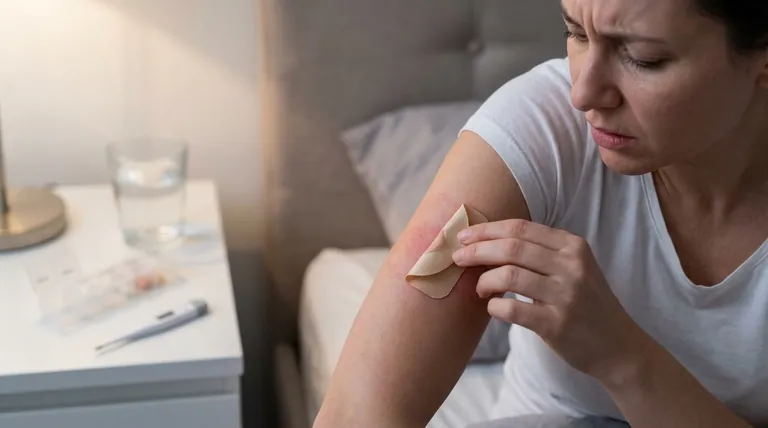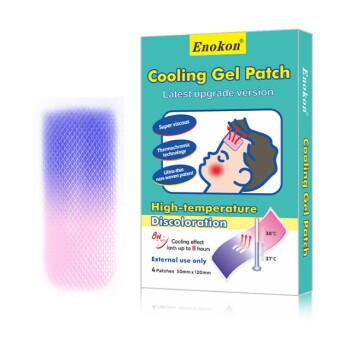Abruptly stopping a medication patch can trigger a wide range of physical and psychological withdrawal symptoms. These may include fever, confusion, severe muscle stiffness, anxiety, depression, insomnia, sweating, pain, and flu-like symptoms such as vomiting, diarrhea, and muscle aches.
The core principle to understand is that your body adapts to the consistent dose from a patch. Stopping suddenly disrupts this balance, causing withdrawal. The only safe method for discontinuation is a gradual tapering plan developed and monitored by your doctor.

A Closer Look at Withdrawal Symptoms
Withdrawal from a transdermal patch is not a single experience but a collection of potential symptoms that can affect your entire system. They can be broadly categorized into physical, psychological, and neurological effects.
Physical and Flu-Like Symptoms
Your body may react with symptoms that feel much like a severe case of the flu as it readjusts.
Common physical signs include sweating, shaking, and general temperature sensitivity. You might also experience a runny nose, watery eyes, goosebumps, muscle aches, vomiting, and diarrhea.
Psychological and Emotional Impact
The disruption can also have a significant effect on your mental and emotional state.
This can manifest as feelings of apathy, a general lack of interest, or more pronounced anxiety and depression. Difficulty sleeping, or insomnia, is also a frequently reported symptom.
Neurological and Cognitive Effects
Some of the most serious withdrawal symptoms involve the nervous system and cognitive function.
These can include a high fever, significant confusion or disorientation, and severe muscle stiffness. These particular symptoms require immediate medical attention.
The Critical Danger of Stopping on Your Own
The primary risk of stopping a patch abruptly is that the withdrawal process is uncontrolled and unpredictable. Attempting to manage this without medical supervision is a significant gamble with your health.
Why Tapering is Non-Negotiable
Your body becomes accustomed to the presence of the medication delivered by the patch. A gradual reduction, known as tapering, gives your system the time it needs to adapt slowly.
Stopping suddenly shocks the system, which is what triggers the cascade of withdrawal symptoms.
The Risk of Severe Complications
Symptoms like high fever, severe muscle stiffness, and confusion can be indicators of a serious medical condition that requires urgent care.
Without professional guidance, it is impossible to distinguish between manageable withdrawal and a true medical emergency. This is why a doctor must oversee the process.
How to Approach Discontinuation Safely
The decision to stop using a medication patch should always be a collaborative one between you and your healthcare provider. Your goal dictates the precise path forward, but the principle of medical supervision is universal.
- If you are considering stopping your medication: Your first and only step should be to schedule a consultation with your prescribing doctor to create a safe plan.
- If you are experiencing negative side effects: Do not simply remove the patch; report the effects to your doctor immediately to discuss dose adjustments or alternatives.
- If you have already stopped abruptly and feel symptoms: Contact a healthcare professional or seek urgent medical care without delay to ensure your safety.
Navigating medication changes is a critical part of managing your health, and doing so under professional medical guidance is the only way to ensure a safe outcome.
Summary Table:
| Symptom Category | Common Examples |
|---|---|
| Physical / Flu-Like | Sweating, vomiting, diarrhea, muscle aches, runny nose |
| Psychological / Emotional | Anxiety, depression, apathy, insomnia |
| Neurological / Cognitive | Confusion, high fever, severe muscle stiffness (Seek immediate care) |
Navigating medication changes requires expert support. As Enokon, a bulk manufacturer of reliable transdermal patches for healthcare and pharma brands, we understand the critical importance of safe and effective medication delivery. Our technical expertise in custom R&D ensures your products meet the highest standards for patient safety. If you are developing or sourcing patches that require precise dosing and reliable performance to minimize risks for end-users, let's discuss how we can support your project. Contact our specialists today for a consultation.
Visual Guide

Related Products
- Herbal Eye Protection Patch Eye Patch
- Far Infrared Heat Pain Relief Patches Transdermal Patches
- Natural Herbal Wormwood Patch Pain Plaster
- Heating Pain Relief Patches for Menstrual Cramps
- Prostate Pain Kidney Health Care Patch for Men
People Also Ask
- Can under eye patches smooth fine lines and wrinkles? Hydrate & Plump for Youthful Skin
- How do eye patches enhance the effectiveness of eye creams? Boost Your Eye Care Routine
- How can using eye patches contribute to a self-care skincare routine? Boost Hydration & Relaxation
- What factors should be considered when purchasing eye patches? Essential Guide for Safe & Effective Use
- How quickly can you see results from using under eye patches? Instant Brightening & Long-Term Benefits


















